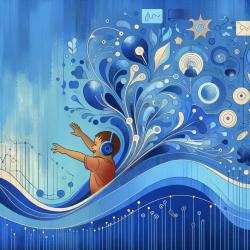Introduction
In the realm of child development, the environment plays a crucial role. Recent research highlights the significance of "blue spaces"—areas with visible water bodies such as lakes, rivers, and oceans—in promoting mental and physical health. The study titled "Measuring Blue Space Visibility and ‘Blue Recreation’ in the Everyday Lives of Children in a Capital City" offers compelling insights into how these spaces can be leveraged to improve outcomes for children. This blog delves into the findings and suggests practical applications for practitioners.
The Power of Blue Spaces
Blue spaces are not just scenic; they are therapeutic. The study conducted in Wellington, New Zealand, utilized wearable cameras to capture the everyday exposure of children to blue spaces. The findings revealed that children from more deprived neighborhoods had higher rates of visual exposure to blue spaces, challenging the notion that proximity to such spaces is a privilege of the affluent.
Key benefits of blue spaces include:
- Mental Health: The calming effect of water bodies can reduce stress and anxiety, providing a serene backdrop for relaxation and reflection.
- Physical Health: Activities like swimming and hiking along water bodies promote physical fitness and well-being.
- Social Connections: Blue spaces serve as communal areas where children can engage in social interactions, fostering a sense of belonging and community.
Implications for Practitioners
For practitioners, integrating the concept of blue spaces into therapy and educational settings can be transformative. Here are some strategies to consider:
- Incorporate Blue Space Exposure: Encourage outdoor activities that involve water bodies. This could be as simple as organizing field trips to local lakes or rivers.
- Leverage Technology: Use virtual reality or videos to simulate blue space environments for children who may not have easy access to them.
- Collaborate with Schools: Advocate for school programs that include blue space exposure, especially in socioeconomically deprived areas.
Encouraging Further Research
While the study provides valuable insights, it also opens avenues for further research. Understanding the specific elements of blue spaces that contribute most significantly to health benefits can refine interventions. Moreover, exploring the long-term impacts of blue space exposure on child development could yield critical information for shaping educational and therapeutic practices.
Conclusion
Incorporating blue spaces into the lives of children is not merely an aesthetic choice but a strategic decision grounded in data. As practitioners, embracing these findings can lead to improved mental and physical health outcomes for children, particularly those in underserved communities. By fostering environments that include blue spaces, we can contribute to a more equitable and health-promoting world for all children.
To read the original research paper, please follow this link: Measuring Blue Space Visibility and ‘Blue Recreation’ in the Everyday Lives of Children in a Capital City.










